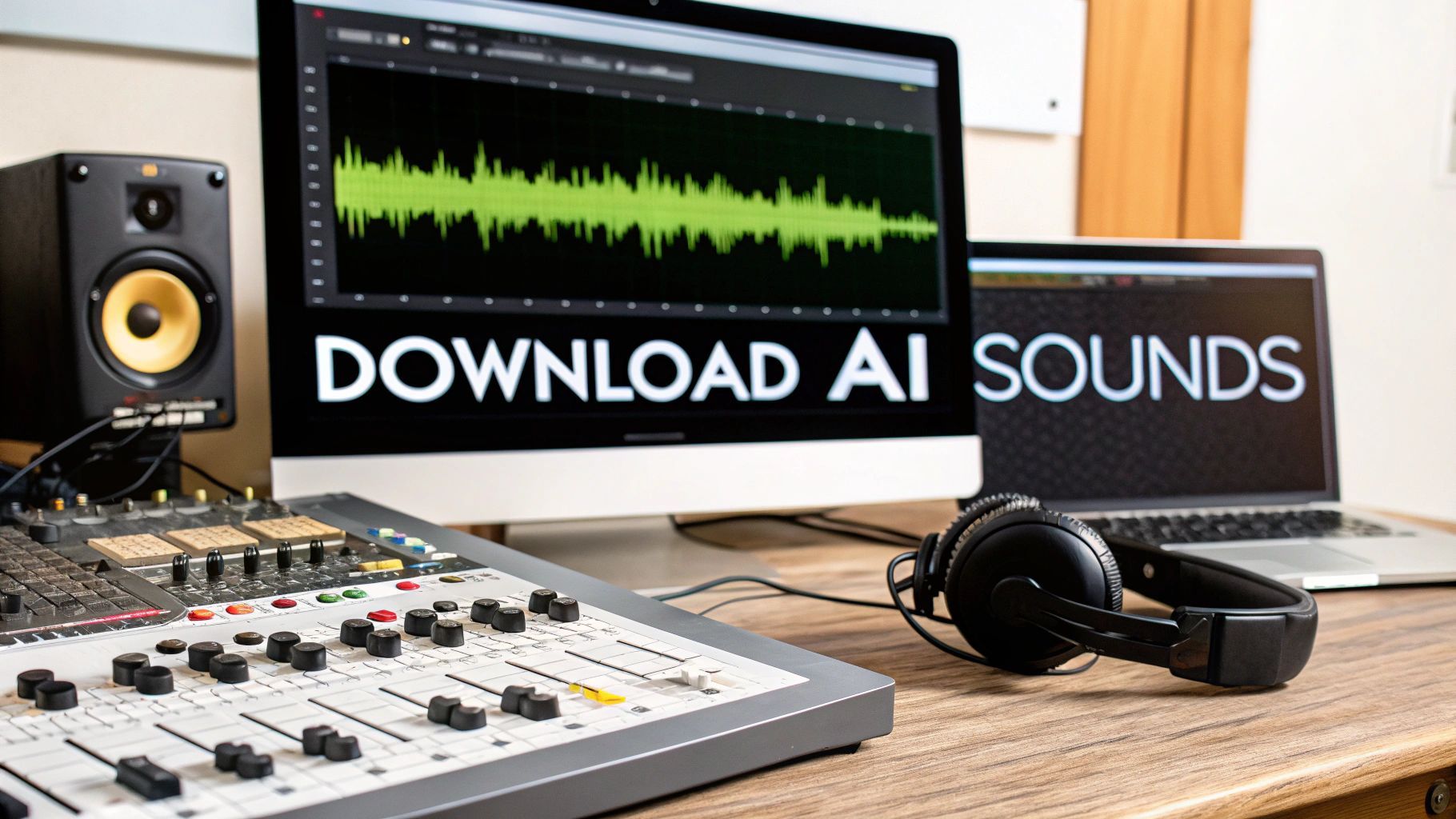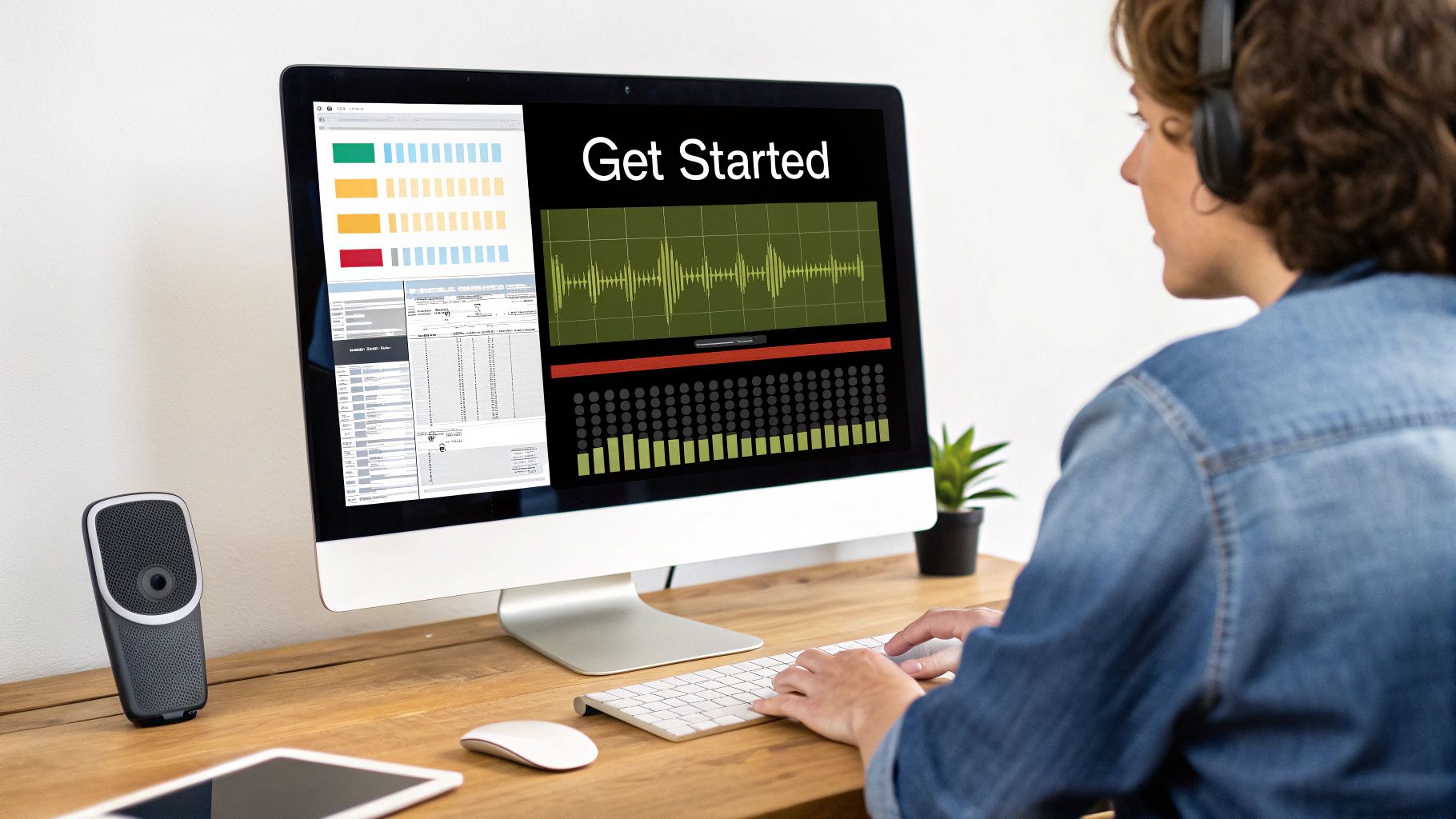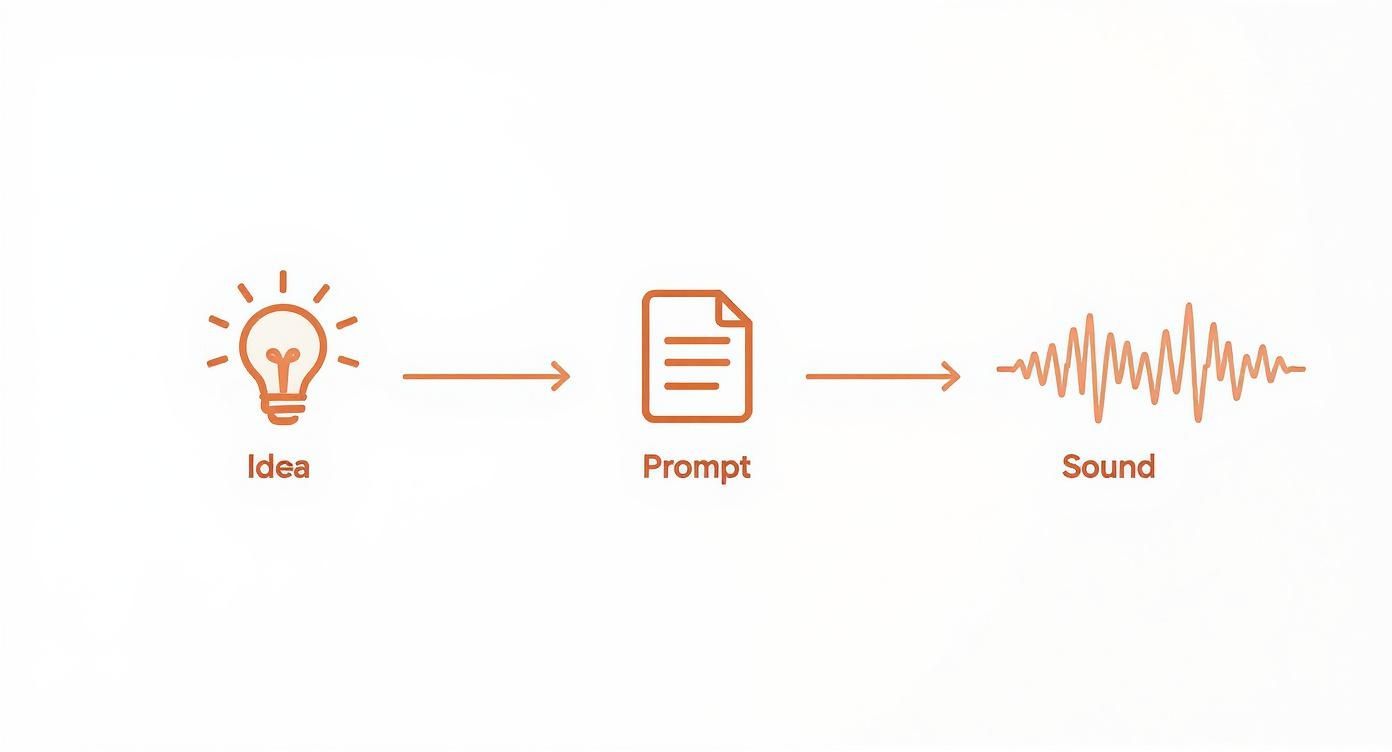
To get sounds out of an AI generator, you first need a place to create them. With SFX Engine, that means setting up an account, getting a feel for the dashboard, and understanding how credits work. Once you've got the basics down, you can start generating sounds and pick the right download format for your project. Let's walk through it.

Before you can even think about downloading, you have to create. This is your launchpad for making custom sound effects with SFX Engine, and the goal is to get you from an idea to your first finished sound as smoothly as possible. We'll stick to the practical steps that actually matter.
Your first move is to create an account. It's a straightforward process that drops you right into the main dashboard. I like to think of the dashboard as the creative cockpit—it's where every audio project starts and where you'll find all the tools to turn your text prompts into reality.
Once you’re logged in, take a minute to get your bearings. You’ll see the main areas for generating audio, managing your library of sounds, and keeping an eye on your account details. Getting comfortable with this layout from the get-go will make your whole workflow much faster later on.
A key part of SFX Engine is its credit system. Instead of locking you into a monthly subscription you might not always need, you use credits. Generating and downloading a sound effect will use up a certain number of credits. This pay-as-you-go model offers a ton of flexibility, which is perfect for creators whose project demands can vary wildly from month to month.
A great way to see how this all works in practice is to experiment with a free AI sound generator. Getting hands-on experience turning text into audio, without any upfront cost, is the best way to build a solid foundation for more ambitious sound design projects.
One of the best habits to form right away is good organization. SFX Engine lets you create project folders, a simple but powerful feature that too many people skip over when they're starting out.
Here’s why it’s a game-changer:
For instance, the minute I land a new client, I create a folder. It might be something like "ClientName_Podcast_S2." Every piece of foley, every intro stinger, and all the ambient tracks for that project live in that one folder. It’s a simple discipline that has genuinely saved me hours of searching.
By mastering these initial steps—setting up your account, learning the dashboard, and organizing your work—you'll be in the perfect position to start making and downloading high-quality, custom sounds for any project you can dream up.
Alright, let’s get into the heart of it—turning your ideas into actual sound. The whole point of an AI sound generator is to take that sound you're imagining and make it real. The trick is learning how to "speak" to the AI through your text prompts. Simply asking for the basics won't get you very far; the real power comes from crafting detailed, descriptive requests.
Think of it like you're directing a voice actor. If you just say "sound sad," you'll get a generic, uninspired performance. But if you say, "sound like you just lost your keys, but you're trying not to cry in public," you'll get something much more specific and powerful. The same idea applies here. Your words are the tools you use to shape the final sound.
Let's walk through a common example. Imagine you need a simple transition for your podcast. A first-timer might just type "whoosh sound." Sure, the AI will give you a whoosh, but it'll be a stock, forgettable one without any personality.
Now, let's get specific. Think about the feel of your podcast.
See the difference? We're using descriptive adjectives and action words. Terms like "clean," "gentle," "sudden," and "rumble" give the AI the exact details it needs to work with. This massively improves the quality and relevance of the sound it generates. Your goal is to paint a picture with your words.
Don't expect to get the perfect sound on your first try. That almost never happens, and that’s okay! Creating sound is an iterative process. It's like sculpting—you start with a big block of clay and slowly chip away until you get it just right.
A great approach is to generate a sound that's close to what you want, then start fine-tuning the prompt. For instance, maybe your "crunchy footstep on dry autumn leaves" prompt sounds a bit too light. Just modify it slightly to "heavy boot crunching on dry autumn leaves, deep, resonant." That one small change gives the AI a whole new direction.
Pro-Tip: Don't be afraid to get a little weird and combine ideas that don't seem to go together. Prompts like "a wooden creak that sounds like a sad whale" can create some incredibly unique and emotionally powerful effects you'd never find otherwise. Experimentation is your best friend here.
To really level up your prompts, it helps to know a few basic sound design terms. Understanding how to describe a sound's texture, pitch, and dynamics will make your requests far more effective.
| Category | Example Keywords to Use in Prompts |
|---|---|
| Texture | Crunchy, smooth, gritty, metallic, wooden, hollow, muffled |
| Pitch | High-pitched, deep, low, bassy, shrill, rumbling |
| Dynamics | Sudden, gradual, crescendo, fading, sharp, soft, explosive |
When you start combining these elements, you can build incredibly detailed prompts. If you want to dive deeper, you can learn more about how to generate audio from text in our guide, which covers more advanced strategies. The more you know, the better you'll get at crafting the exact sound you need.
You’ve done the creative part and generated the perfect sound effect. Now, let’s get that audio file out of SFX Engine and into your project. Getting this right is about more than just clicking a button; it’s about making a few smart choices upfront that will save you a ton of hassle later.
Once the AI has worked its magic, you'll see the download option. This is your first and most important decision point: the file format. This isn’t just a technical box to tick—it has a real impact on your sound's final quality.
This handy visual breaks down the whole journey, from a simple idea in your head to a finished audio file ready for action.

It all starts with translating your creative vision into a clear text prompt. The AI takes that prompt and turns it into the sound you hear, which you can then download and use.
You'll almost always be choosing between WAV and MP3. Here's my take on it from years of working with audio: think of a WAV file as your original, uncompressed master recording. It’s the highest fidelity version, containing every last bit of audio data. This is what you want for professional work—film, music production, or high-end video games where every sonic detail counts.
An MP3, on the other hand, is a compressed file. It cleverly strips out the parts of the sound that our ears are least likely to miss, which makes the file size way smaller. This is perfect for things like websites, mobile apps, or podcasts, where you need things to load quickly and don’t want to eat up storage space.
Each time you download a sound from SFX Engine, it costs credits. You can always see your credit balance right on the dashboard, which makes it easy to keep track. If you're working on a bigger project—say, building the entire soundscape for a short film—you could easily be downloading dozens of effects. A little planning goes a long way in making sure you don't run out of credits mid-flow.
Here’s a pro tip that sounds simple but will save you endless frustration: get into the habit of naming your files logically from the very beginning. A filename like Footstep_Gravel_HardSole_01.wav is a million times more helpful than Sound_Final_2.wav when you're searching your library a week later. Trust me, it makes your assets searchable and keeps your projects from turning into a chaotic mess.
Don’t forget, downloading is the final, crucial step. It’s the moment your AI-generated idea becomes a real, tangible file you can drop right into your timeline, game engine, or audio workstation.
The way we access audio has changed dramatically. We went from physical media to digital downloads, and now streaming is king. In fact, global recorded music revenues hit a massive US$29.6 billion in 2024, with over 50% of that coming from streaming services. But even with streaming's dominance, the multi-billion dollar market for direct downloads shows that creators still need and want to own their files.
And remember, generating sounds is just one part of building a great audio library. It's also smart to know where to find existing resources. For instance, looking into things like the best free sleep sound apps can give you a stash of ready-to-use ambient tracks. When you combine AI-generated effects with curated sound libraries, you end up with a seriously powerful and versatile toolkit.
Grabbing a single sound effect is one thing, but that’s rarely how incredible audio design works in the real world. The best projects build rich, immersive worlds by weaving multiple sounds together, and that’s where you can really start to make your work stand out.
The magic truly begins when you start layering your sounds. Think of it like a painter adding depth and texture to a canvas. You might start with a base ambient track from SFX Engine, something like "light rain on a window," but then you'll want to layer more specific, generated sounds on top of it.
For example, adding a distinct "distant thunder rumble" and a subtle "wind whistling through a small crack" can completely transform that simple rain sound. Suddenly, you have a whole atmospheric scene. Once you pull those individual files into your audio editor, you can adjust the volume and placement of each layer to build a soundscape that feels deep and incredibly realistic.
Downloading a high-quality WAV file gives you fantastic raw material to work with, but the final professional polish almost always happens in post-production. Don't be shy about experimenting with some basic audio effects—they can make an enormous difference.
Two of the most powerful tools in your kit are EQ (Equalization) and Reverb.
I have one hard-and-fast rule: always start with less. It's so easy to overdo an effect like reverb, which can quickly make your audio sound fake and washed out. Add just a tiny bit, listen back, and then slowly add more until it sits perfectly in the mix.
The real power of a tool like SFX Engine is how you can use it for highly targeted professional work. If you're a filmmaker, you could generate a whole collection of custom Foley sounds. Instead of digging for a generic "key jingle," you can create the exact "heavy brass keys jingling on a rusted iron ring" that you see on screen.
For a mobile app developer, the focus might be on unique user interface (UI) sounds. You can craft a "soft, bubbly click for a positive confirmation" or a "short, clean digital chirp for a notification." These bespoke sounds are what give an app its personality and feel. This demand for top-tier audio isn't slowing down; in fact, it's growing, largely because user hardware is getting better and better.
The global consumer audio market hit a value between USD 56.59 billion and USD 100.24 billion in 2024. As technology like AI-driven sound personalization becomes more common, user expectations for a premium, polished experience are only going to rise. This trend highlights just how important it is to create unique, high-quality audio for every project you touch. You can read more about how consumer audio technology is evolving and see where the industry is headed.
By really digging in and mastering these more advanced techniques, you’ll be ready to create audio that not only meets those high expectations but blows them away.

Downloading sounds is one thing, but keeping them organized is what really separates a smooth creative workflow from a chaotic mess. Honestly, a well-managed library is a game-changer—it means finding that perfect sound in seconds, not minutes.
This discipline starts the moment you hit "download." I can't stress this enough: get a consistent folder structure set up on your computer. It’s a non-negotiable. For example, I have a main "SFX Library" folder, and then I immediately break it down by project—"Podcast Season 2," "Indie Game Project," you name it.
Inside those project folders, I drill down even further with subfolders. A simple system might look like this:
This kind of hierarchy prevents your download folder from turning into a digital graveyard of randomly named files. To really level up your organization, it’s worth looking into some digital asset management best practices.
That same organizational mindset should carry over to your SFX Engine account. The platform has built-in project folders for this exact reason, and I highly recommend using them to mirror the structure on your local drive.
It’s incredibly handy for keeping track of which sounds belong to which client or creative project. Plus, it gives you a clean visual overview of your work, making it a breeze to revisit past projects or find that one specific effect you generated months ago.
Think of your sound library as more than just a folder of files. It’s a personal toolkit you're building over time. Every sound you generate and organize is an investment in your future creativity, saving you a ton of time and effort down the road.
Finally, let's touch on credits. They're the currency you use on SFX Engine, so managing them well is key to keeping your creative flow uninterrupted. You can always see your current credit balance right on your dashboard.
Keeping an eye on this number helps you plan ahead. When you need to top up, you've got options: one-time credit packs for smaller jobs, or monthly subscriptions that offer much better value if you're a heavy user. Just think about your typical monthly usage and pick a plan that makes sense for your output and budget.
This way, you always have the resources you need without overspending. And for those just starting out or working on a tight budget, don't forget to explore options for a free sound effects download to supplement your custom-generated library. When you manage both your files and your credits wisely, SFX Engine becomes a truly sustainable part of your creative process.
When you're deep in a creative project, the last thing you need is a technical snag. Let's get you quick, straightforward answers to the questions we hear most often about downloading sounds from SFX Engine so you can get back to what you do best.
This is a classic question. The easiest way to think about it is like a professional photograph versus a quick snapshot you'd post online.
A WAV file is the original, uncompressed master recording. It contains every bit of audio data, giving you the highest possible quality. If you're working on a film, a high-end video game, or any professional audio project where fidelity is king, WAV is your go-to.
An MP3, on the other hand, is a compressed file. It's much smaller, which is great for saving space, but that size reduction comes at the cost of some audio detail. This format is perfect for things like mobile apps, podcasts, and web content where smaller file sizes and faster load times are a top priority.
Yes, you absolutely can. This is one of the biggest perks of using SFX Engine. Every sound you create and download is royalty-free.
That means you can confidently drop them into your commercial video game, your monetized YouTube channel, or your indie film without ever worrying about future licensing fees or legal headaches. It’s a huge time-saver.
For creators, knowing your assets are royalty-free is a massive weight off your shoulders. It lets you focus on the creative work instead of getting bogged down in complex licensing agreements for every single sound you use.
That depends entirely on how you got them. If your credits are part of a monthly subscription plan, they usually reset at the end of each billing cycle. Think of it as a "use it or lose it" situation designed for regular users.
But if you bought a one-time credit pack, those credits typically stick around for a much longer time—sometimes they don't expire at all. The definitive answer for your specific credits is always waiting for you in your account dashboard.
Okay, don't panic. If a download fails, it's usually one of a few simple things. First, run through the basic checklist: Is your internet connection stable? And more importantly, did you check your account to make sure you have enough credits?
If you've confirmed both of those, the next step is to try clearing your browser's cache or even just using a different browser (like Chrome or Firefox). A quick log-out and log-in can also work wonders. Still no luck? The SFX Engine support team is your best bet for a fast solution.
Ready to stop searching and start creating? With SFX Engine, you can generate the exact sound effect you need from a simple text prompt, all royalty-free. Give it a try today at https://sfxengine.com.